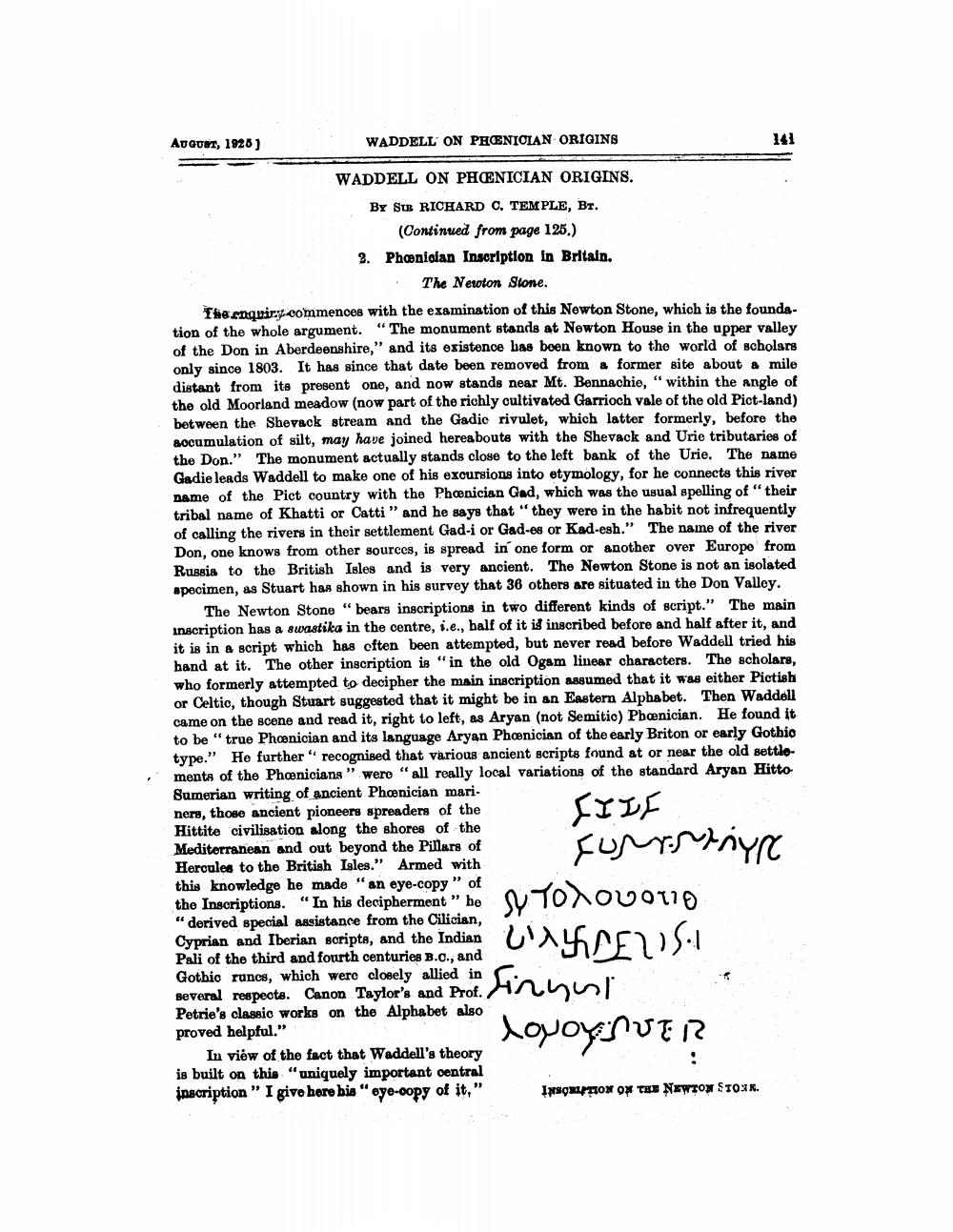________________
AUGUST, 1928)
WADDELL ON PHENICIAN ORIGINS
WADDELL ON PHENICIAN ORIGINS. BY SIR RICHARD C. TEMPLE, BT.
(Continued from page 125.) 3. Phonioian Inscription in Britain.
The Newton Stone. The engvir...commences with the examination of this Newton Stone, which is the foundation of the whole argument. "The monument stands at Newton House in the upper valley of the Don in Aberdeenshire," and its existence las boen known to the world of scholars only since 1803. It has since that date been removed from a former site about a mile distant from its present one, and now stands near Mt. Bennachie, "within the angle of the old Moorland meadow (now part of the richly cultivated Garrioch vale of the old Pict-land) between the Shevack stream and the Gadie rivulet, which latter formerly, before the socumulation of silt, may have joined hereabouts with the Shevack and Urie tributaries of the Don." The monument actually stands close to the left bank of the Urie. The name Gadie leads Waddell to make one of his excursions into etymology, for he connects this river name of the Pict country with the Phoenician Gad, which was the usual spelling of "their tribal name of Khatti or Catti " and he says that "they were in the habit not infrequently of calling the rivers in their settlement Gad-i or Gad-es or Kad-esh." The name of the river Don, one knows from other sources, is spread in one form or another over Europe from Russis to the British Isles and is very ancient. The Newton Stone is not an isolated specimen, as Stuart has shown in his survey that 36 others are situated in the Don Valley.
The Newton Stone bears inscriptions in two different kinds of script." The main inscription has a swastika in the centre, i.e., half of it is inscribed before and half after it, and it is in a script which has often been attempted, but never read before Waddell tried his hand at it. The other inscription is "in the old Ogam linear characters. The scholars, who formerly attempted to decipher the main inscription assumed that it was either Pictish or Celtic, though Stuart suggested that it might be in an Eastern Alphabet. Then Waddell came on the scene and read it, right to left, as Aryan (not Semitio) Pbænician. He found it to be "true Phoenician and its language Aryan Phænician of the early Briton or early Gothic type.” He further recognised that various ancient scripts found at or near the old settlements of the Phænicians" were "all really local variations of the standard Aryan Hitto Sumerian writing of ancient Phoenician mariners, those ancient pioneers spreaders of the Hittite civilisation along the shores of the Mediterranean and out beyond the Pillars of Hercules to the British Isles." Armed with this knowledge he made "an eye-copy" of the Inscriptions. "In his decipherment” he "derived special assistance from the Cilician, Cyprian and Iberian scripts, and the Indian Pali of the third and fourth centuries B.O., and Gothic runes, which were closely allied in several respects. Canon Taylor's and Prof. Petrie's classic works on the Alphabet also proved helpful."
In view of the fact that Waddell's theory is built on this "uniquely important oentral inscription " I give here his "eye-copy of it." I MPTION ON THE NEWTOX STOR.
کررکر
Turrrrnyro 1ολουοτιο 214EVIS.1
finnut
lowonurl?




